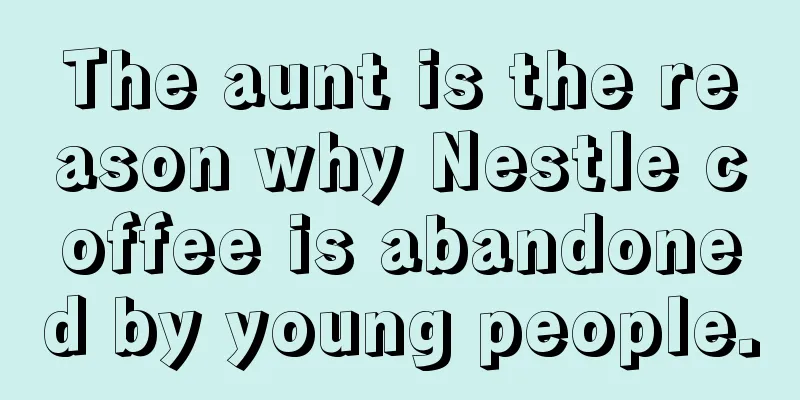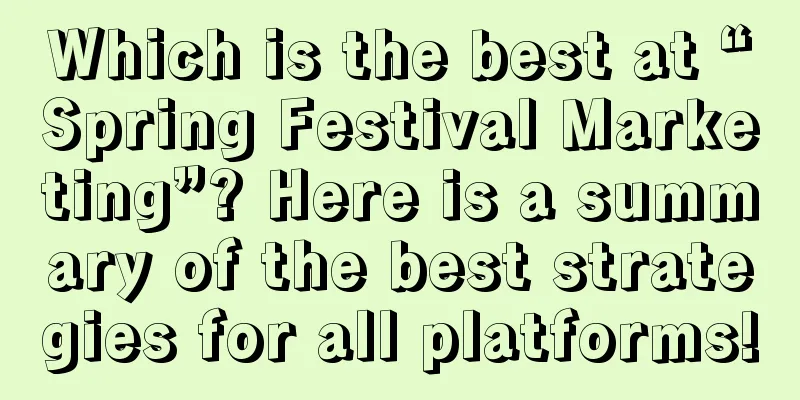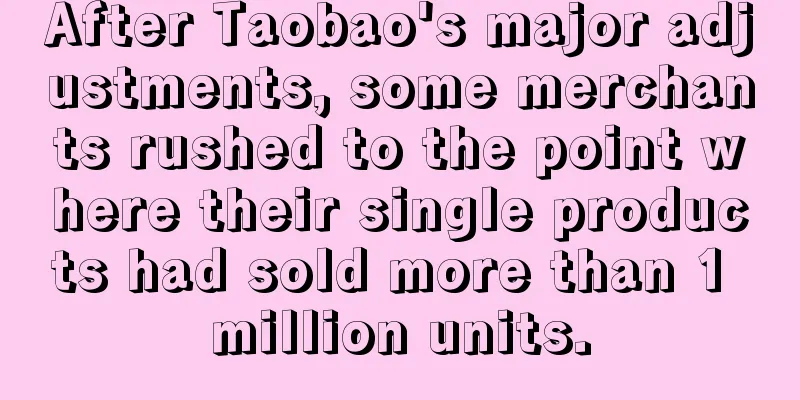The aunt is the reason why Nestle coffee is abandoned by young people.

Unexpectedly, Nestle instant coffee, a childhood memory, was made popular by a Nanjing grandma. Not long ago, a food blogger @蟹蟹老板 on Douyin posted a video of himself buying a cup of handmade coffee for 10 yuan on the streets of Nanjing. Unlike the hand-brewed coffee we understand, Nanjing grandma's "hand-brewed coffee" is three strands of Nestle instant coffee brewed with hot water. The aunt also said that she only uses Nestle and no other brands. This contrasting video not only made Nanjing grandma popular, but also Nestle instant coffee popular. Looking beyond the perspective of netizens and starting from the brand perspective, netizens' attitudes towards Nestlé instant coffee show several different trends, which also indirectly reflects the brand impression of Nestlé, the "pioneer of instant coffee", in the eyes of current consumers and the impact of changes in coffee culture on Nestlé. First, explain why the Nanjing grandma chose Nestle instead of other instant coffee brands: In the eyes of the aunt, Nestle is the best brand. In the era when Nestle set off the instant coffee trend, consumers of different ages knew that instant coffee = Nestle, and the brand effect was very strong. The second is to raise questions from the perspective of lifestyle changes, such as "Isn't Luckin Coffee at 9.9 yuan delicious?" or "Auntie doesn't understand coffee beans, nor does she understand Luckin Coffee Santonban." When people have more choices for drinking coffee, who would still choose to drink the Nestle instant coffee that was popular more than a decade ago? No one cared about the marketing for ten years, but the whole world knew about it after one cup of hand brewed coffee. Is drinking Nestle instant coffee really a renaissance? Nestle coffee, which once claimed to be the "first cup of coffee", seems to no longer be exclusive to young people. 1. Under attack from both inside and outside, is Nestlé abandoned by young people?Nestlé had recorded the lifestyles of the previous generation of coffee consumers, so when consumer groups migrated and lifestyles changed, external pressure emerged. In 1988, Nestlé opened the door for Chinese consumers to explore coffee culture with the slogan "It tastes great". Coffee Wave 1.0 began to sweep the Chinese market, and instant coffee was the protagonist of this wave. In 1999, Starbucks began to enter the Chinese market. As the top representative of coffee culture at the time, Starbucks began to write Starbucks' high-end coffee culture. In 2016-2017, domestic coffee brands began to rise. "O2O coffee" represented by Luckin Coffee and Lian Coffee began to develop. At the same time, the high-end boutique instant coffee represented by Santonban kicked off. From 2018 to date, coffee has become more popular, and the trend towards fine coffee and price wars have been launched simultaneously. Consumers have begun to pursue coffee quality, and the competition landscape has entered a white-hot stage. Data shows that in 2015, some consumers began to try coffee shops and coffee beans, and the number continued to increase; in 2018, consumers began to like new forms such as coffee liquid, filter coffee, and capsule coffee, among which the sales of more convenient coffee liquid soared; the annual per capita consumption of freshly ground coffee in China also increased from 9 cups in 2016 to 16.74 cups in 2023. With the irreversible changes in lifestyle, Nestlé is indeed no longer the first cup of coffee for young people. The first cup of coffee for young people can be Luckin Coffee, Starbucks, or Santonban. Another pressure comes from the aging brand image within Nestlé. In the Knife Brand Kinetic Energy Theory, brands have two different dimensions: kinetic energy and potential energy. Potential energy represents what value consumers are paying for in a brand, and kinetic energy represents how a brand uses speed to capture the market. Different brands may start with strong energy and then accumulate kinetic energy, or they may start with accumulated kinetic energy and then tell a potential energy story. Ultimately, they rely on kinetic energy accumulation to provide a continuous source of business for the brand. When Nestlé Coffee first entered China, it successfully accumulated unshakable brand potential energy by spending huge amounts of money on TV advertising. And the strong potential energy played an important role in its development of offline distribution. Subsequently, Nestlé paid great attention to building an offline distribution system and the layout of e-commerce channels. After more than ten years of development, brand kinetic energy has become a strong barrier to Nestlé Coffee's revenue. But the potential energy on the other side has decreased. Since entering China, the brand image created and accumulated during the traditional marketing period has been used to this day, which is why the "cheap" brand image has always followed Nestle Coffee. In the knife-based potential energy theory, the potential energy is divided into seven levels based on Maslow's hierarchy of needs theory, namely: food and clothing needs, sense of security, love and belonging, sense of respect, cognitive needs, aesthetic needs, and self-realization. However, after Nestlé Coffee completed the initial accumulation of its brand image, it was not used to integrating into the new consumer-centric marketing era. Therefore, the failure to understand the consumer group became the core reason for the aging of the Nestlé brand. When consumers needed products to meet their "aesthetic needs", "sense of respect", "love and belonging", Nestlé was absent. The reason why Nestle Coffee can become the "ancestor of instant coffee" is that Nestle Coffee has strong capital and can afford to create a world, and there are no strong competitors to compete with it. But sir, times have changed, and cheap and good instant coffee is no longer the only Nestle. Consumers need not only the functional value provided by coffee, but also the spiritual value of the brand. However, Nestle Coffee's marketing concept is mainly to promote product functions, lacking storytelling and content marketing that can communicate with consumers, and even rarely launches story-telling brand TVCs, not to mention new marketing strategies such as brand personalization and contrast marketing. At this time, Nestlé is like an elephant turning around. Although it is difficult, it has to seek change. 2. Nestlé’s counterattack: adjusting products and continuing to expand into lower-tier citiesAware of the changes in lifestyles and consumer groups, Nestlé Coffee began to shift its product strategy to "become the first cup of coffee for more people." To this end, it launched four major moves. In the years when premium instant coffee brands such as Santonban were in the limelight, Nestlé’s first strike back was aimed at the growing “premium instant” market. In 2018, Nestlé spent $7.15 billion to buy out Starbucks' bagged coffee business, allowing it to permanently sell Starbucks coffee beans, boutique instant and capsule coffee. This means that the financial sponsor behind the bagged Starbucks we buy in stores or online is Nestlé. In 2021, Nestlé Coffee designed and launched the Starbucks Cup for the Chinese market, and the product packaging is similar to that of Santonban. The acquisition of Starbucks' packaged coffee business also brought new growth to the Nestlé Group. The 2022 financial report showed that Starbucks product sales reached 27 billion yuan, an increase of 12.9%. What is less known is that Nestlé Coffee has also launched a boutique instant coffee brand with a very Chinese flavor - "Gan CAFE". In 2017, Nestlé Coffee cooperated with Ogilvy to present Gan CAFE to consumers in the form of a pop-up store. It was not until 2020 that the online sales of Nestlé instant coffee soared due to the epidemic, and Gan CAFE also officially announced the launch of physical products with a high-end positioning. In the same year, the brand entered the top 10 of Tmall's emerging brand list. Unfortunately, the highly anticipated Gan CAFE was discontinued in 2022. The reason behind it is unknown. Daofa speculates that it may be because the timing of the internal evaluation was not good, and it may conflict with Starbucks' bagged coffee business. Nestlé's second move is aimed at the freshly ground coffee business. While Starbucks and Luckin Coffee competed for the "third space", Nestlé Coffee set its sights on the office scene. In 2018, Nestlé Coffee launched the "Office Café" project, where you can have a cup of freshly ground coffee in 2 minutes. This project was upgraded after Nestlé and Starbucks reached a global coffee alliance in 2019, and launched a comprehensive coffee solution for Chinese consumers, "Starbucks Coffee Service", for out-of-store experience scenarios. According to official introduction, in the three years of cooperation between Nestlé and Starbucks, there are more than 2,000 coffee service points outside Starbucks stores, covering different channels such as office tea rooms, high-end hotels, high-speed railways, universities, hospitals, high-end car 4S stores, high-end sales offices and high-end golf clubs. Of course, as the "originator of instant coffee", how can it be willing to give up the low-end market. Since the boutique coffee is popular in first- and second-tier cities, the third sword of Nestlé coffee has begun to penetrate into third- and fourth-tier cities. In 2018, Bernie Stefan, Vice President of Nestlé Asia, Oceania and Africa, revealed the future development strategy of Nestlé coffee. “We found that people in first- and second-tier cities drink more coffee, while people in remote areas still drink less. From a business perspective, remote areas are areas with potential.” In the market gap when Starbucks and Luckin Coffee were not able to penetrate deep into the market, Nestle Coffee made instant products of different prices enter KA and street alleys through deep distribution. Consumers in third- and fourth-tier cities can drink high-quality Starbucks instant coffee without going to the store, and students can also drink Nestle instant coffee to achieve a refreshing effect. According to Chanmama data, more than 65% of Nestlé's consumer groups come from third-tier, new first-tier and second-tier cities, and the proportion of first-tier cities is equivalent to that of fourth-tier cities. In the past, "convenient and fast" was synonymous with instant coffee. But after the change of lifestyle, instant coffee that still needs to be brewed with hot water is not convenient. Therefore, when Nestlé believed that the Chinese coffee culture had reached a certain stage, the fourth sword intended to provoke a war of instant coffee. Three years ago, Nestlé Coffee began to promote its ready-to-drink products as a key focus. He Wenlong, senior vice president of Nestlé Greater China's coffee business, mentioned that ready-to-drink coffee is very suitable as consumers' first cup of coffee in terms of product, price and taste. It is more convenient than instant coffee and can also be popularized with the help of Nestlé's strong distribution capabilities. He pointed out, "In the past, Nestlé China relied solely on instant coffee to start consumers' "first cup of coffee". Now, ready-to-drink coffee has also become an important magic weapon to drive consumers into the coffee market." As a flavored beverage, ready-to-drink coffee is more innovative than other categories. It can not only keep up with changes in consumer tastes anytime and anywhere, but also attract more new users. 3. Marketing breakthrough, Nestlé coffee is more "young"Since the Nestlé Group spun off the Greater China region, Nestlé Coffee's new marketing strategy has become richer than before, and it has begun to move from a big brand to young consumers. He Wenlong, senior vice president of Nestlé's coffee business in Greater China, once said: "Against the backdrop of the upgrading of national coffee consumption, Nestlé Coffee has never stopped exploring the consumption needs and emotional attachment of the younger generation. We use different categories, different forms and different channels to start the 'first cup of coffee' for more people." If you want to understand contemporary students, start with the “Study Room” on Bilibili. Students have always been the target consumers of Nestlé instant coffee. Therefore, Nestlé started from the living habits of contemporary students and tried to find a new intersection between exams and coffee. In 2022, Nestlé's "100 Exams to Become Coffee" marketing campaign revitalized the brand in front of students. "Bai Kao Cheng Ka" tapped into the trend of students studying at home during the epidemic. It was learned that students have developed the habit of using virtual study rooms on Bilibili. Students account for a relatively high proportion of Bilibili's user base, which is close to Nestle instant drinks. At the same time, the strong learning atmosphere is irreplaceable on other social media platforms. Based on this, Nestlé designed virtual study room themes of different styles and launched them on Bilibili, accompanying students in preparing for the exam through cloud live broadcast. Nestlé also found UP hosts in the learning area of Bilibili and asked them to broadcast live, covering exam preparation knowledge, mentality adjustment, and answering skills, and directed traffic to Nestlé's virtual study room. In addition, Nestlé raised its marketing awareness by officially announcing celebrity spokespersons, launched a new "100 Exams to Become a Scholar" limited theme packaging, and launched the Red Cup Study Room on the Tsinghua campus offline, etc., so that Nestlé instant can "become friends" with the student group again. Music festival, and Nestle special fruit extract is more suitable. After music festivals became a hot new marketing method for major brands, Nestlé Coffee was not willing to lag behind and found China's well-known Strawberry Music Festival and jointly held a coffee event filled with specially blended fruit extracts - "Young people should be awake and happy." In 2023, the first May Day holiday after the epidemic was lifted, ushered in an explosion of music festivals around the country. Nestlé entered the music festival scene for the first time, and joined hands with Strawberry Music Festival to start a "coffee tour" in Shanghai, where the trendy culture and coffee culture are strong. In order to be closer to the taste experience of young consumer groups, Nestlé specially launched special fruit extract raw coconut latte, special fruit extract peach latte, etc. It also played a limited joint venture, and launched a cross-border joint gift box with Strawberry Music Festival for sale on e-commerce channels. In the traditional marketing era, Nestlé's marketing strategy for new products can be summarized by a set of formulas: spokesperson + outdoor advertising + TV placement = new product marketing. After Nestlé Coffee became younger, it began to learn to use unexpected collaborations to leverage content to promote new product launches. Collaborated with the famous band Sunset Rollercoaster to promote iced coffee; jointly promoted the special blended milk tea coffee with the popular IP "Empresses in the Palace"; also collaborated with Black Cat Sheriff and cooperated with offline famous coffee shops. In these joint actions, Nestlé's joint strategy is to find popular IPs that match the product characteristics. The marketing strategy targets a wide range of people, mainly young people born after 1990. In terms of physical perception, Nestlé Coffee's new marketing strategy is not innovative, and the connection with the IP is relatively severed. The brand potential has not been accumulated in these joint ventures. Although the marketing is interesting, Nestlé Coffee has not left a mark in our hearts. This is something that Nestlé Coffee needs to reflect on. It is worth mentioning that in April this year, Nestlé Coffee held a brand renewal conference and announced that it would begin to adopt a new logo, integrating multiple sub-brands ("Nestlé Coffee 1+2", "Silky Latte", and "Pure") into the parent brand "Nestlé Coffee" to reduce consumers' cognitive costs. Starting from 2021, Nestlé's new marketing strategy has become more intensive and is accelerating. As a new marketing trainee, the brand rejuvenation of Nestlé Coffee is on the way, but it does not mean that the rejuvenation progress has been 100%. From a marketing perspective, Nestlé Coffee's new marketing strategy seems to lack a bit of soul. Joint music festivals and cooperation with popular IPs are techniques, and the truth lies in why consumers buy Nestlé coffee products. This is also the fundamental reason why Nestlé Coffee's marketing strategy has not impressed consumers at a time when it is becoming more intensive. Competing in product launches and marketing speed may no longer be the winning strategy in this era. 4. Analyst CommentsFor Nestlé Coffee, it may be more appropriate to replace brand rejuvenation with integrating into consumers' lifestyles. Even in the years when coffee culture in China is booming, coffee, as an imported product, still represents a lifestyle. Even drinking instant coffee means that consumers have aspirations for life. Coffee represents different lifestyles for consumers in different cities and different classes. The only thing in common is that young, quality-conscious and more accessible consumers are always more willing to try coffee. Integrating into the lifestyle is like falling in love with consumers. It is not about being in front of them anytime and anywhere, nor is it about winning their hearts by giving them gifts. What is more important is to be able to match their souls, to be by their side, and to understand what gifts they want. References:
Author: Lao Xie; Editor: Hua Dao WeChat public account: Knife Skills Research Institute |
<<: MINISO, walking between high-quality products and imitations
>>: Cat memes dominate the charts on three platforms, hitting three key elements of a hit
Recommend
With millions of followers gained in a week, what new tricks has “Warm Family” come up with?
This article starts from the Douyin blogger "...
In 2023, what else can companies do to acquire customers online at low cost?
Corporate marketing has always faced an old proble...
Kuaishou declares war on Douyin, who will be the final winner?
The two short video giants, Kuaishou and Douyin, h...
Douyin business interview track is not a good business
In the wave of short video development, every play...
Anti-fraud guide! Nine ways to falsify data
When doing data analysis, you have data to analyze...
Targeting Dianping, why is Douyin poaching Dianping users?
As the short video app TikTok continues to grow in...
Moutai launched Xunfeng Yuan Universe. What do you think?
Recently, Moutai launched the "Xunfeng Digita...
Real opportunities and strategic analysis of the consumer industry in 2023
The analysis of the consumer industry on the marke...
Brand is the sum of business operations
Since modern times, the development of business or...
DHgate.com's Notice on Intellectual Property Complaints
In view of the increase in appeal-related inquirie...
With revenue increasing fivefold in one year, how did Yongpu Coffee develop its private domain to achieve growth?
Coffee has only been popular in China for a short ...
Pinduoduo merchants’ self-positioning: helping the platform make money or helping the platform gain users
On e-commerce platforms, the value exchange betwee...
How to chat with sellers on eBay? How to contact customer service?
For eBay sellers, if they want to run a good store...
What are the techniques for Amazon distribution? What are the differences between Amazon distribution and boutique products?
In today's e-commerce field, Amazon, as one of...
How can Lazada open other sites? How can I register and open a store on Lazada?
For sellers who want to expand their business scop...









